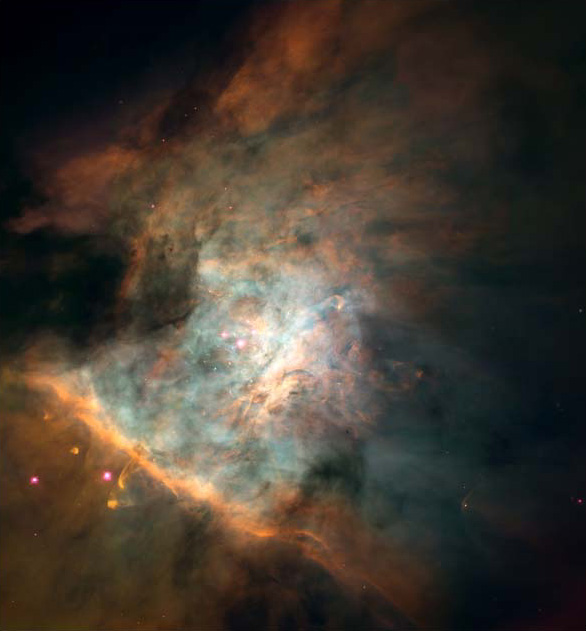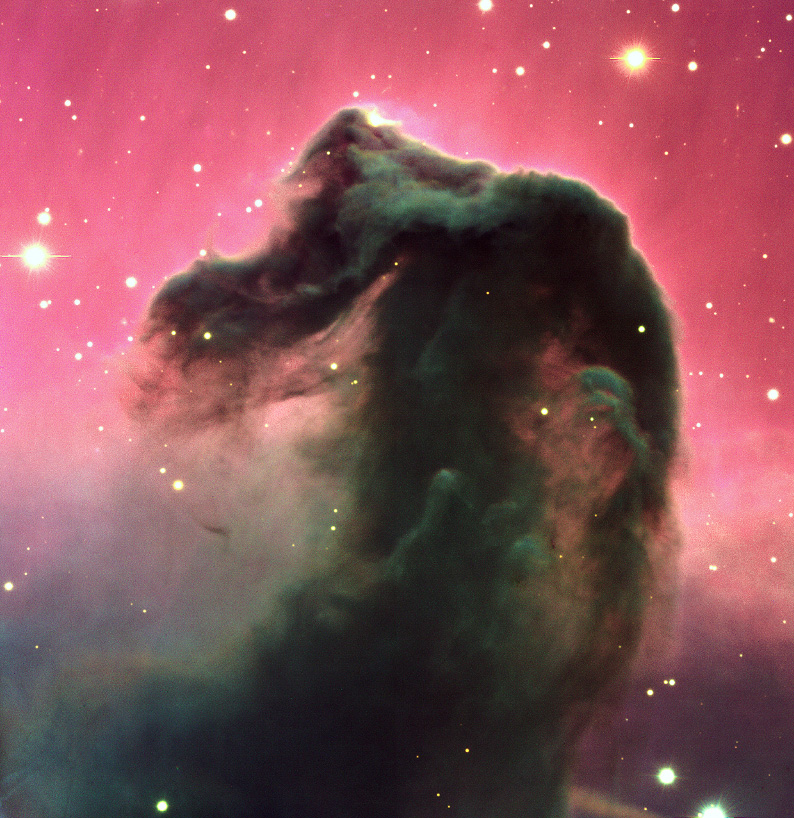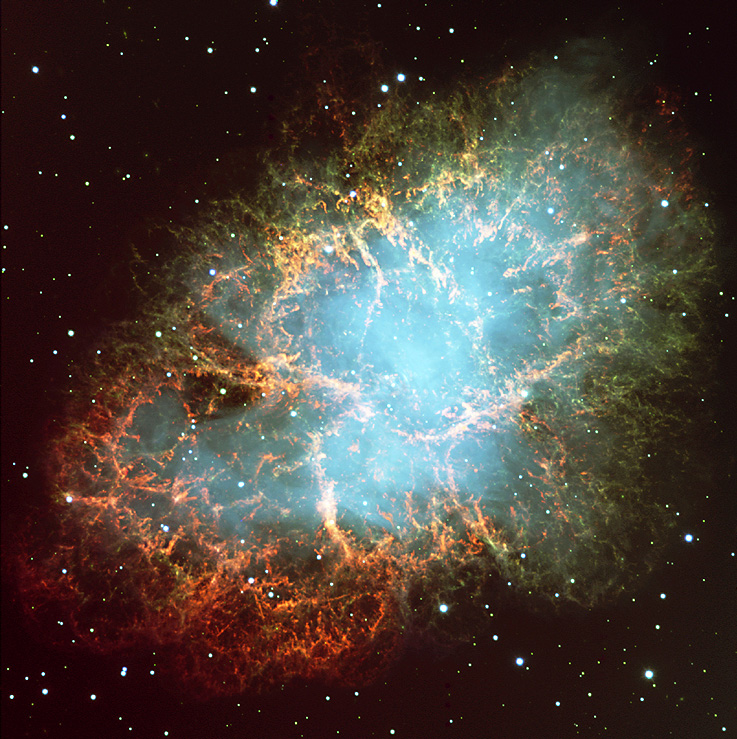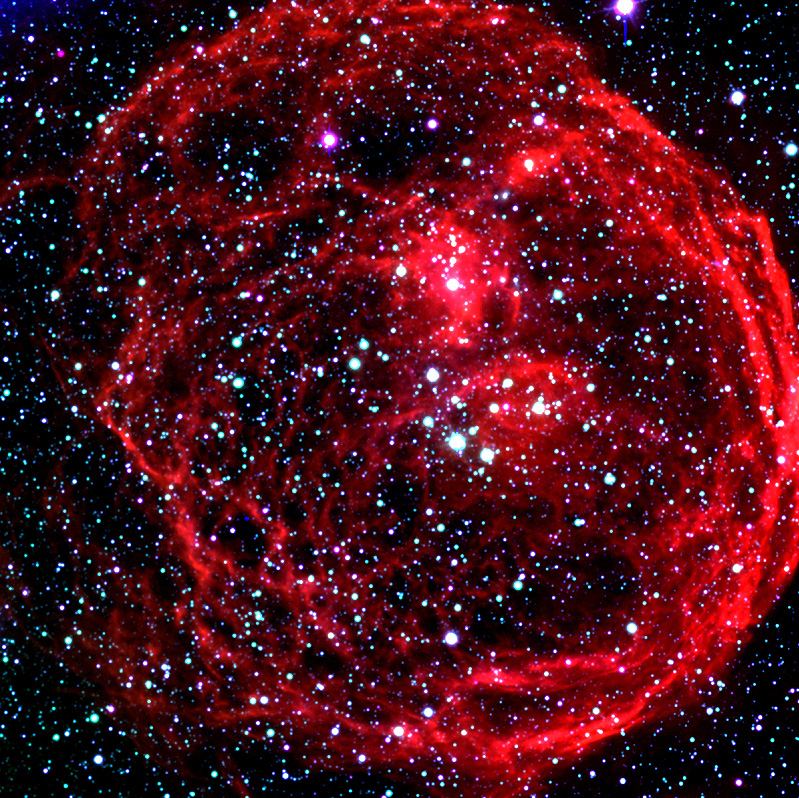 National Aeronautics and Space Administration
National Aeronautics and Space Administration
| Educational Product | |
|---|---|
| Educators & Students | Grades 9-14 |
Educational Brief
CHIPS SCIENCE INVESTIGATION
Exploring the Interstellar Medium
Objectives
|
|
National Science Education Standards
|
NCTM Math Standards
|
Materials
|

If you go out at night, far away from the city lights, you can see a band of diffuse light stretching across the sky. This is the Milky Way Galaxy, an enormous disk of stars. Our Sun is inside this disk about two-thirds of the way out from the center. All of the thousands of individual stars visible to the naked eye at night are also inside this disk. In the Milky Way Galaxy alone, there are over 100 billion stars. The disk of the Milky Way is about 100,000 light-years in diameter and about 1,000 light-years thick. This means the average distance between stars is over four light-years. A light-year is the distance light travels in one year (9.45 trillion kilometers). The nearest star to the Sun is Proxima Centauri and is 4.2 light-years away. To give you a sense of scale, if the Sun were the size of a grapefruit (10 cm in diameter) then Earth would be the size of a pinhead located 10.7 meters away from it. If this grapefruit-Sun were located in Los Angeles, California then Proxima Centauri would be another grapefruit located in New York City. Space is vast! Many people have the mistaken idea that space is completely empty, a perfect vacuum. In fact, the space between stars in the Milky Way Galaxy is filled with very thin gases that can be either hot or cold, and microscopic grains of dust. This matter is called the Interstellar Medium (ISM) and may contain important clues about the formation and evolution of planets, stars, and galaxies. Let us now explore this Interstellar Medium and learn about some of the critical roles it plays in the Universe.
 Figure 1: The Orion Nebula. Visible in the winter evening skies as the middle star of Orion’s sword, this star-forming region is 1,500 light-years away and 26 light-years across. This image is of the central 2.5 light-year region.
Figure 1: The Orion Nebula. Visible in the winter evening skies as the middle star of Orion’s sword, this star-forming region is 1,500 light-years away and 26 light-years across. This image is of the central 2.5 light-year region.
|
The Interstellar MediumThe vast spaces between stars in a galaxy is not completely empty, it is sparsely sprinkled with gas and dust. This ‘stuff’ between the stars is known as the Interstellar Medium. About 99% of the ISM is hydrogen and helium gas; the remaining 1% consists of gases and dust of heavier elements. The gas is extremely dilute, with an average density of about 1 atom per cubic centimeter. The air we breathe is approximately 30 quintillion (30,000,000,000,000,000,000) times more dense than the ISM. Picture this: an “empty” coffee mug in the ISM would contain about 500 hydrogen atoms. The same “empty” coffee mug sitting on your desk contains about 1,500 quintillion (1.5 x 1021) gas molecules - mostly nitrogen, oxygen, and carbon-dioxide. The typical density of the dust in interstellar space is even less than that of the gas. In one cubic kilometer of interstellar space you would find, on average, only 1,000 grains of dust. So, while the space between stars is not a perfect vacuum, it has a density about one trillion times less than the best “hard vacuums” ever created in laboratories on Earth. At such low densities, it may seem to you that the ISM is barely there at all. But remember, space is huge. All that matter adds up in the vastness between the stars. For example, the inner 16 light-years of the Orion Nebula contains enough mass in gas and dust to make up more than 300 Suns. |
The dust in the ISM is made of tiny, irregularly shaped particles of silicates (minerals with silicon and oxygen as the fundamental ingredients), carbon, ice, and iron. The typical size of a dust grain is 0.1 microns (1 micron is 1 millionth of a meter). The wavelengths of visible light are of similar size (0.4 – 0.7 microns), which means visible light can be absorbed and scattered by the dust grains. In areas where the dust is thicker than average, the light from nearby stars can be completely blocked - similar to the way dark clouds block light from the Sun. Figure 2 shows the Horsehead Nebula (nebula is a Latin word meaning cloud) - the dark area in the center of the photograph (shaped like a horse’s head) is a thick cloud of interstellar dust blocking the light. Thinner clouds of interstellar dust may dim the light passing through, without completely blocking it. This is known as extinction. Because the typical sizes of interstellar dust grains are similar in size to shorter (blue) wavelengths of visible light, blue light is scattered and absorbed more effectively than red light. This means that most of the light that reaches us through the interstellar dust is reddish. This is known as interstellar reddening. A similar process happens here on Earth at sunset. Molecules of air on Earth scatter blue light more than red light, and when the Sun is low on the horizon its light passes through so much air that there is almost no blue light left in it, and the Sun appears a reddish-orange color. |
 Figure2: The Horsehead Nebula.
Figure2: The Horsehead Nebula.
|
|
In nebulae, light from nearby stars can also be reflected off of the interstellar dust and gas, similar to the way light from a car’s headlights can reflect off fog. Because blue light is more easily scattered (and reflected) by clouds of dust and gas, some nebulae appear to have a bluish color and are called
reflection nebulae. The sky of Earth is blue for the same basic reason. As sunlight passes through the atmosphere blue light is scattered into random directions by nitrogen molecules in the air. In addition to absorbing and scattering light, the gas in the ISM can emit its own light. In regions containing very hot, newly-formed stars, ultraviolet radiation emitted from the stars strips electrons from the atoms of the hydrogen gas, a process called ionization. When these electrons recombine with the ionized hydrogen, red light is emitted from the hydrogen gas. This accounts for the red colors in photographs of nebulae, such as the Orion and Trifid Nebulae (Figures 1 and 3). In the image of the Trifid Nebula in Figure 3 we see part of the cloud glowing red because young, hot stars within are ionizing it. The outer parts of the nebula are reflecting blue light from those same hot stars. There are also dark lanes of concentrated dust, which are blocking the light of stars and gas behind them. |
 Figure 3: The Trifid Nebula
Figure 3: The Trifid Nebula
|
|
The hydrogen gas in the ISM can also form relatively cool clouds that emit light in the radio band of the electromagnetic spectrum. These cool clouds of hydrogen can collapse under their own weight. It is here, in these dense, collapsed clouds known as stellar nurseries, that new stars and planetary systems can form out of the ISM matter. |
|
.jpg) Figure 4: NGC 3603
Figure 4: NGC 3603
|
Understanding the Life Cycle of Stars and the ISM |
|
The ISM literally contains the seeds of future stars, and all the stars we see were once formed out of the same kind of diffuse gas and dust. When the gas in the ISM cools, gravity takes hold and clouds begin to collapse. The gas forms clumps that can develop into stars and planets. In fact, this is probably how our solar system was formed. One of the biggest puzzles in astrophysics is the process that turns these very diffuse, hot and cold gases and dust in the ISM into stars. The enhanced-color photograph from the Hubble Space Telescope in Figure 4, captures various stages of the star life cycle. To the upper left of center is the blue supergiant star named Sher 25, which is near the end of its life. Near the center is a cluster dominated by young, hot stars. The three small dark clouds in the upper right corner are so-called Bok globules, which are in an early stage of star formation. The gold-colored clouds are ionized hydrogen gas in the ISM. [NOTE: this ionized hydrogen appears gold rather than red because of the color enhancement done during the processing of the image] |
|
 Figure 5: The Crab Nebula
Figure 5: The Crab Nebula
|
Processes that heat the ISM are fairly well understood. Stars blow winds of gas and dust particles off their surfaces throughout their lives. The most massive stars blow the strongest winds transferring huge amounts of energy into the ISM. Very massive stars also violently explode only a few million years after their formation, stirring and heating the gas out of which they formed. Such an exploding star is called a supernova. These injections of energy from supernovae and stellar winds profoundly affect the ISM and determine the rate at which new stars form. However, even after decades of study, the process by which this diffuse gas in the ISM cools and influences the star formation remains one of the enduring puzzles of astrophysics. In order to understand how stars form, it is necessary to understand how this extremely hot gas cools. NASA’s new mission, the Cosmic Hot Interstellar Plasma Spectrometer (CHIPS), is studying the cooling of gas in the Sun’s galactic neighborhood. The Local Bubble: Our Astronomical NeighborhoodOur solar system is located in an unusual region of space called the Local Bubble. The Local Bubble is about 300 light years in radius and is filled with extremely low density gas (about 0.001 gas molecules per cubic centimeter) - this is much less dense |
| than the ISM surrounding it. The coffee mug that would contain about 500 hydrogen atoms in the average ISM would only contain 1 hydrogen atom (or maybe none at all!) if it were in the Local Bubble. This gas is also extremely hot—about 1 million degrees Kelvin (1.8 million degrees Fahrenheit), or almost 200 times as hot as the surface of the Sun! Despite such high temperatures, if you were to stick your unprotected hand into the Local Bubble environment it would freeze. This is due to the difference between temperature and heat. Temperature is a measure of the average energy of motion per gas particle. Heat is a measure of the sum of energy from the motion of all the gas particles. The gas particles in the Local Bubble may have very high energies on average (temperature), but because the density is so low there would be few of them interacting with your hand. So, very little heat would be felt. It is the extremely diffuse gas, inside the Local Bubble, that the CHIPS mission is studying. | |
|
Astronomers hypothesize that the Local Bubble may have been created by a supernova explosion several million years ago - that is, the explosion “blew” most of the gas and dust from the interstellar medium outward. Supernovas are one of the most violent and energetic events in the Universe. They can result from either the death of a star many times more massive than the Sun or from a strange kind of star, called a white dwarf, that accumulates matter from a companion until it explodes. In 1054 A.D., Chinese astronomers recorded a ‘guest star’ that appeared in the constellation of Taurus for several days. For a short while this star shined as brightly as the Moon. When modern telescopes peered at the location recorded by the Chinese astronomers, they found the remains of a star that had blown itself up—the Crab Nebula (Figure 5). The Crab Nebula is an example of a young supernova remnant. It is still relatively compact (only 10 light-years in diameter) and expanding rapidly with filamentary structures inside. The bubble, named N70, in Figure 6 is located in the Large Magellanic Cloud (LMC), a small galaxy orbiting the Milky Way. It is about 150 light-years in radius and is filled with hot tenuous gas. It is likely the result of not just supernova explosions but also strong stellar winds from hot massive stars inside the bubble. Because the Local Bubble is much larger, it is probably the remnant of a much more ancient supernova than either the Crab or the supernovas that created N70. |
 Figure: N70 in the LMC
Figure: N70 in the LMC
|
